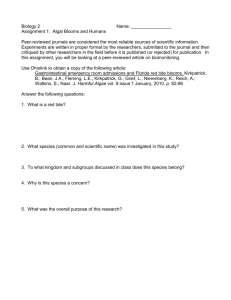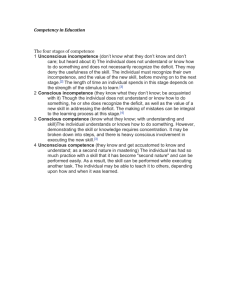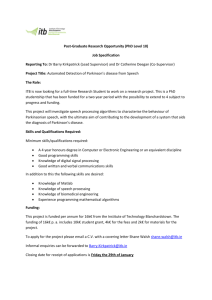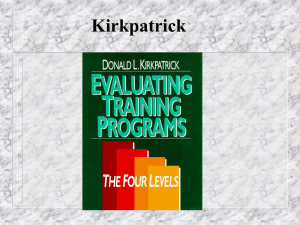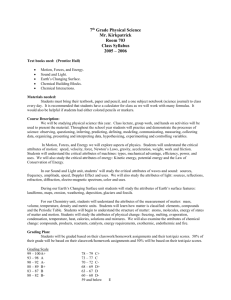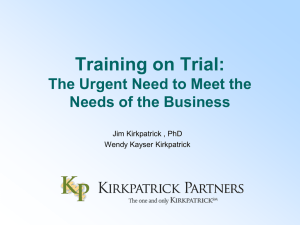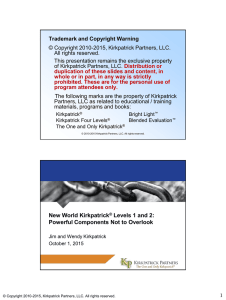Evaluation of Strategic HRD
advertisement
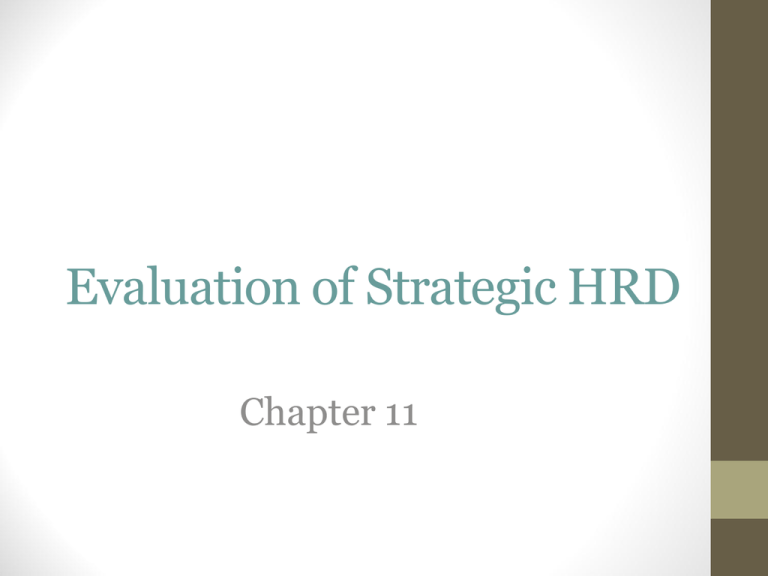
Evaluation of Strategic HRD Chapter 11 Why Evaluate ? The Purpose of Evaluation: Viewpoints & Challenges • Evaluation is a core part of what makes us compete or competitive. • Evaluation is important from three different perspectives 1. First view point: Gauging success • Persons who took part in the development or learning process are interested 2. Second view point: Whether financial & time investment paid off? • Stakeholders are interested 3. Third view point :Evaluation of the development design • The designers and facilitators of the training program or process are interested. The Evaluation Process The Focus of Evaluation • Understand the parameters of evaluation • Look inside the boxes of parameters The Parameters of Evaluation • Defines “What we are trying to evaluate” • Should have clear and measurable learning objectives • Learning objectives are best indicators of the purpose of the learning intervention • HRd has a more strategic role to play and the evaluation needs to be adapted accordingly • Supports a notion of fit between learning objectives and evaluation focus The Evaluation Process Evaluation areas of SHRD: Drawing parameters Level & Time Individual dimensions (current and enabling) Team/Department (current and enabling) Organization (current and enabling) Formal Program Focus of conventional evaluation Some evidence of formal evaluation Needs Development: Kirkpartrik level 4 adresses this to some extent Informal Process Could be captured in performance appraisal but is often not acknowledged as part of SHRD processes Could be captured in performance appraisal but is often not acknowledged as part of SHRD processes Needs Development The Evaluation Process Evaluating learning outcomes Kirkpatrick’s four-level framework for categorizing training outcomes Level 1: REACTIONS-What does participant feel about the training? Level 2: LEARNING-What factors or information did the participant gain? Level 3: BEHAVIOUR- What skills and competencies did the participant gain, an how are these used in the workplace Level 4: RESULTS OR EFFECTIVENESS- What results can be tracked as a result of the participants applying their skills and knowledge The Evaluation Process Evaluating learning outcomes Kirkpatrick’s four-level framework for categorizing training outcomes 1. The first level of these learning outcomes refers to the participants’ immediate reaction to the training programme. 2. The second level of Kirkpatrick’s evaluation content model refers to cognitive outcomes 3. The third level of Kirkpatrick’s evaluation content model refers to the assessment of skill based outcomes 4. The fourth level relates to the impact of the development process on the organization as a whole The Evaluation Process Evaluating Informal Training • Managerial learning is often regarded as most suited to the informal learning sphere. • The key “input” criteria for evaluation of the informal learning process can be grouped into: 1. The learning potential of the job context Is the work environment conducive to informal learning? The variation of subcultures Does my team value learning 2. The “Person” characteristics Self Efficacy Instrumentality The Evaluation Process The Timing of Evaluation Evaluation point Purpose First point: Prior to training & development Review purpose of training and provide input into the learning objectives. Assess skill level before learning intervention Second point: During training Participants and facilitator want to guage performance improvements (kirkpatrick level 2) Could use data to feed back into the learning design Third point: Post-program, delivery but prior to workplace transfer Reactions to the training program (kirkpatrick level 1) Perceptions of the facilitators as well as the learning process. Gain insight into whether the administration & structure of the program was effective Fourth point: Post-program,on-thejob, approximately 3 months after re-entry Transfer of learning (kirkpatrick level 3) Ability to practise skill, Information about necessary changes to the workplace can be identified Fifth point-Post-program,on-thejob, approximately 6 months after re-entry Transfer of learning (kirkpatrick level 3) Impact on organizational performance as well as individual performance (kirkpatrick level 4) Identify future training and development needs The Evaluation Process The Tools for Evaluation The most frequently used instrument or tools include: Questionnaires Interviews Focus groups Observations Skill tests The Evaluation Process The impact of Evaluation itself • Evaluation as a process can be a powerful illuminator of organizational interrelationships and the influence of culture on learning and success • Evaluation uncovers performance issues: it tells us what works well and more importantly, when it works well. • Previous research found that a key indicator of the organizational performance is discretionary behaviour • These data, gathered through observation and interview methods, could also indicate 1. How the organizational culture influences performance 2. Whether there are powerful subcultures that have an impact on learning 3. Which managerial styles are more conducive to learning The Evaluation Process The “Why”, “Who”, “When”, “How” and “What” of Evaluation WHY? WHO? WHAT? WHEN? HOW? Gauging performance improvements“How well am I doing?” Participants, Facilitators, HRD function Kirkpatrick Levels 2 & 3 During training program and upon completion of program Skill-based tests, Observation, Interviews Return on Investors, investmentHRD function “Was it worth it” Kirkpatrick Level 4 Upon return to workplace (long term= 6 to 12 months) Questionnaires, Human Capital Accounting Program design“What worked” Kirkpatrick Level 1, with some emphasis on levels 2, 3 & 4 Directly upon completion of program (reactions) Questionnaires, Interviews, Focus groups HRD function
